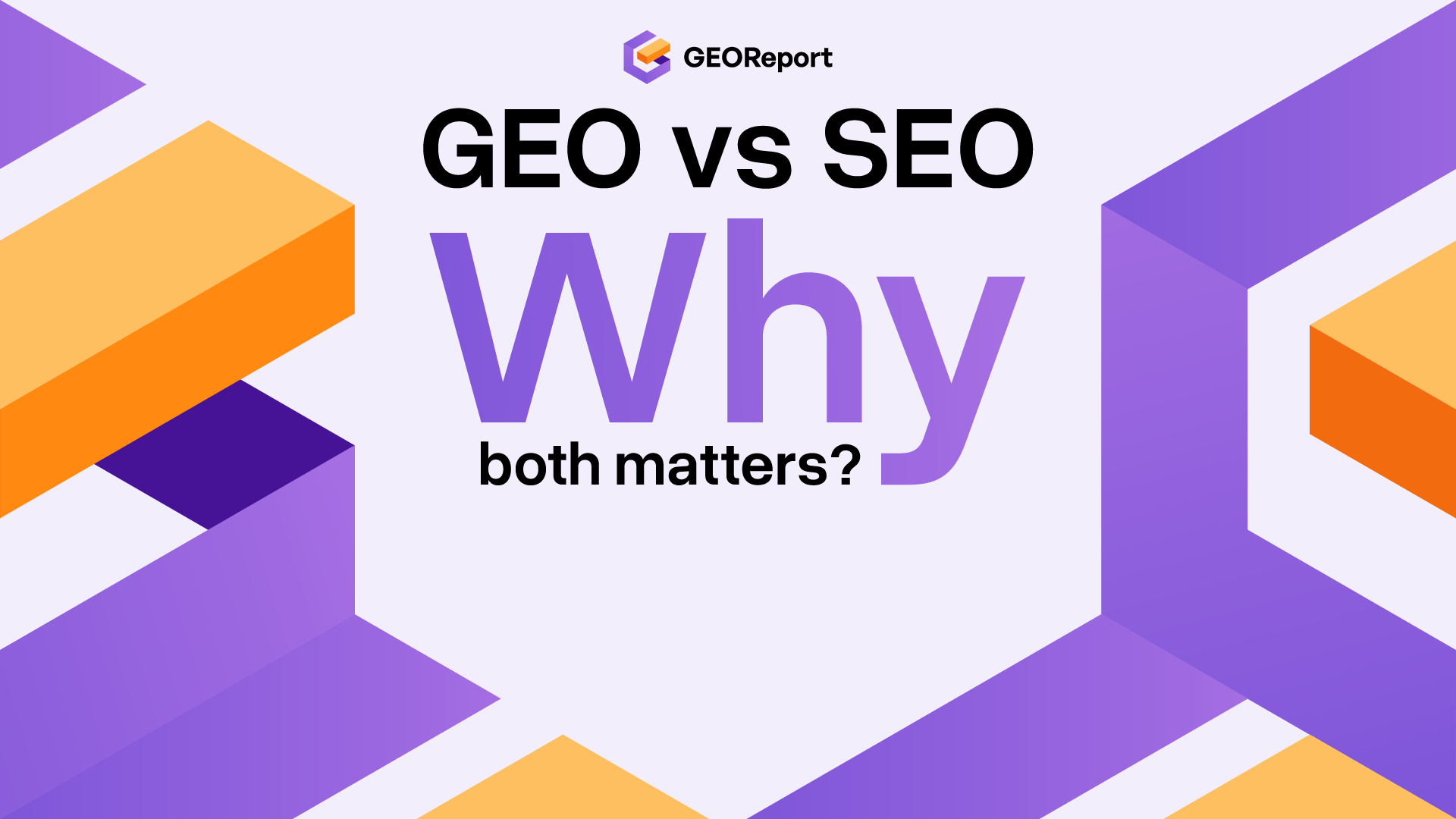GEO and SEO: Why both matters?

For over two decades, Search Engine Optimization (SEO) has been the backbone of digital visibility. But the evolution of generative AI like ChatGPT and Gemini has introduced a new player: Generative Engine Optimization (GEO).
This article explores why SEO is still vital but no longer enough. We'll break down what GEO is, how it complements SEO, and why a dual strategy is now essential for brand visibility & authority in the AI-driven search era.
Table of Contents
- What is Search Engine Optimization (SEO)? Why is it still the foundation?
- What is Generative Engine Optimization (GEO)?
- How do AI engines like ChatGPT and Gemini change the user journey?
- GEO vs SEO: Key Differences
- How can you build a strategy for both GEO & SEO?
- What Tools Can Help Measure and Improve Your GEO Performance?
- Conclusion
- FAQs
What is Search Engine Optimization (SEO)? Why is it still the foundation?
Before diving into the new landscape, it's crucial to understand the bedrock of digital discoverability: SEO. It's the practice of optimizing your website to rank higher in Search engine results pages (SERPs) for specific keywords, driving organic traffic.
What is the core of SEO?
Traditional SEO is broadly built on three essential pillars that work together to build a site's credibility and ranking potential.
- On-Page SEO: This involves optimizing individual web pages to rank higher and earn more relevant traffic. It includes high-quality content, keyword research, optimizing title tags, meta descriptions, and header tags.
- Off-Page SEO: These are actions taken outside of your own website to impact rankings. The most significant factor here is building high-quality backlinks from other reputable websites, which act as a vote of confidence for search engines.
- Technical SEO: This focuses on the backend of your website to make sure it can be crawled and indexed efficiently by search engines. Key elements include site speed, mobile-friendliness, site architecture, and XML sitemaps.

Why does SEO remain critical in the age of AI?
Even as AI chat becomes a primary source for answers, SEO's importance has not diminished, it has evolved. Generative AI assistants like Gemini and ChatGPT are not creating information from thin air; they are trained on the vast, existing index of the web that Google and other search engines have spent decades building.
- AI Needs a Source of Truth: High-quality, well-structured content that ranks well in traditional search is more likely to be found, used as a source by AI assistants during their training and information retrieval processes.
- Authority Signals Carry Over: The signals that tell Google your site is authoritative and trustworthy like backlinks, clear structure, and expert-level content are the same signals to an AI that your information is reliable. Strong SEO is one of the prerequisites for being considered a credible source by AI.
What is Generative Engine Optimization (GEO)?

While SEO gets your website on the list, Generative Engine Optimization (GEO) turns your content into part of the conversation. It represents a fundamental shift from ranking in a list to being the answer itself.
What is GEO?
Generative Engine Optimization (GEO) is the practice of strategically structuring and creating content to be discoverable, understood, and favorably presented by generative AI assistants. The goal isn't just to appear in a list of links; it's to have your brand, data, or key points directly integrated and cited within the AI's generated response. To reach that goal, you must improve AI brand Visibility by using GEO.
What kind of content performs well for GEO?
Content optimized for GEO is meticulously crafted to be machine-readable and human-valuable. It prioritizes clarity and factual accuracy above all else.
- Intent-Centric Answers: AI assistants are designed to answer questions. Content that directly addresses a user's query in a clear, concise manner is more likely to be selected. This means focusing on long-tail, question-based keywords.
- Factual Accuracy and Data: AI prioritizes verifiable facts and data. Citing sources, including statistics, and presenting objective information builds the credibility needed for an AI to trust your content.
- E-E-A-T: Google's concept of E-E-A-T (Expertise, Experience, Authority, Trust) is even more critical for GEO. AI assistants are actively programmed to avoid misinformation, so they look for content written by credible experts with demonstrable authority.
This new discipline requires a dedicated approach. For those new to the concept, understanding What is Generative Engine Optimization (GEO)? The Playbook for AI Visibility is the perfect starting point to build a foundational knowledge.
How do AI engines like ChatGPT and Gemini change the user's journey?
The rise of generative AI is fundamentally altering how people seek information. This isn't just a new feature; it's a new user behavior. The traditional search journey is being replaced by a more conversational, direct, and synthesized experience.
How does user intent differ between traditional search and AI chat?
The change in interface leads to a profound change in user behavior and expectations.
- Traditional Search Journey: A user enters a query (e.g., "best content marketing tips"), receives a SERP with 10 blue links, and then clicks through multiple sources, manually comparing and synthesizing the information to find their answer.
- AI Search Journey: A user asks a more complex, conversational question (e.g., "As a small business owner, what are the top three most effective content marketing strategies I can implement with a limited budget?"). They expect a single, comprehensive, and direct answer, often with follow-up capabilities.

What does "AI visibility" mean for a brand?
AI visibility is the new metric for success in this paradigm. It’s no longer just about traffic. In fact, research shows the new AI-driven search landscape could significantly impact website traffic.
Success in this new environment means:
- Direct Mentions: The AI explicitly names your brand in its response (e.g., "According to HubSpot, a key strategy is...").
- Source Citations: Your article is linked as a primary source for the information provided.
- Conceptual Adoption: The AI adopts your unique framework, definition, or data as the standard answer, even without a direct mention.
The way these different models source and present information varies significantly, making a one-size-fits-all approach ineffective. A deep understanding of How Different AI assisstants Rank Content is crucial for developing a robust, multi-platform GEO strategy.
GEO vs. SEO: Key Differences
While GEO and SEO are deeply interconnected, each focuses on different primary goals and are measured by different metrics. Understanding their complement to each other is key to creating a holistic digital strategy.
How do their primary objectives compare?
This table breaks down the core distinctions between SEO and GEO
| Aspect | Search Engine Optimization (SEO) | Generative Engine Optimization (GEO) |
|---|---|---|
| Primary Goal | Rank high on a Search Engine Results Page (SERP). | Be featured, cited, or used as a source in an AI-generated response. |
| Target Audience | Users scan a list of links to find information. | AI assistants seeking verifiable data & users looking for direct answers. |
| Key Tactic | Keyword optimization, backlink building, technical health. | Factual accuracy, clear data structure, E-E-A-T, intent-centric writing. |
| Success Metric | Keyword rankings, organic traffic, click-through rate (CTR). | Brand mentions, source citations, traffic from AI referrals. |
Where do GEO and SEO overlap?
The synergy between GEO and SEO is powerful. They are not competing priorities; one builds upon the other.
- Quality Content is King: High-quality, well-researched, and expertly written content is the foundation for both.
- Structure is a Universal Language: Clear HTML structure (H1s, H2s, lists, tables) makes it easy for both search engine crawlers and AI assisstants to parse and understand your content's hierarchy and key points.
- E-E-A-T as the Ultimate Trust Signal: A strong E-E-A-T profile is perhaps the most important overlapping element. It signals to both systems that your content is reliable and worthy of being shown to users.
How can you build a strategy for both GEO & SEO?
Creating a unified strategy doesn't mean doubling your workload. It means refining your existing content processes to meet the demands of both humans and AI. The goal is to create content so clear, authoritative, and helpful that it excels in any environment.
What is the "Answer-First" content model?
Adopt a content model that prioritizes answering questions directly and comprehensively.
- Focus on Long-Tail Keywords: Shift your keyword research from broad terms to the specific, conversational questions your audience is asking.
- Use FAQ Schemas and Sections: Structure content with clear questions and answers. FAQ sections are easily digestible for both users and AI assisstants.
- Create Data-Rich Content: Develop articles, studies, and reports with original data and statistics. This makes your content a prime source for citation.
How do you optimize for E-E-A-T across both platforms?
Building trust is non-negotiable. It's the currency of the modern web.
- Cite Credible Sources: Always link out to authoritative studies, expert opinions, and primary sources to back up your claims.
- Showcase Author Expertise: Include detailed author bios that highlight credentials, experience, and expertise in the subject matter.
- Maintain Content Freshness: Regularly update your content to ensure all information, especially statistics is current as of 2025.
How can you measure and adapt your new strategy?
This is the new challenge. Measuring GEO is a new frontier. Unlike Google Analytics for SEO, direct attribution from AI is complex and often not available. Without the right tools, you're flying blind, unable to know if your efforts are leading to valuable brand mentions and citations.
To succeed, you need a clear view of your AI visibility. Platforms like GEOReport are designed specifically for this, providing a toolkit to measure your brand’s presence across like ChatGPT, Gemini, Claude, and Perplexity. Auditing your content with a GEO-focused tool helps identify gaps and deliver actionable insights to boost your visibility where users are increasingly looking for answers.
A forward-thinking strategy requires both creation and measurement. For a practical checklist on implementation, consider these 10 Actionable GEO Tips to Optimize Your Content for AI.
What Tools Can Help Measure and Improve Your GEO Performance?
A successful strategy relies on a toolkit for both execution and measurement. While the SEO toolkit is mature and well-established, the GEO toolkit is rapidly emerging to meet new demands.
What tools exist for traditional SEO?
For decades, marketers have relied on a suite of powerful SEO platforms to track rankings, analyze backlinks, and perform keyword research. These are still essential.
- Ahrefs and SEMrush: Industry leaders for backlink analysis, keyword research, and competitive intelligence.
- Google Search Console: A free tool from Google that is indispensable for monitoring your site's health, performance, and indexing status in traditional search.
- Moz Pro: Offers a comprehensive suite of tools for all aspects of SEO, from rank tracking to site audits.
What are the emerging tools for GEO?
Measuring AI visibility requires a new class of tools designed to track performance within closed AI ecosystems.
Specialized platforms like GEOReport are pioneering this space. This tool actively query major AI assistants to track how and where your brand is being mentioned, providing analytics, actionable insights and detailed fix guides.
Conclusion
The digital landscape is undergoing its most significant shift since the advent of the search engine. While SEO remains the indispensable foundation for making your content discoverable on the web, GEO is the critical next step to ensure your brand has a voice in the AI-driven future.
The two are not competitors; they are partners. SEO builds the stage, and GEO directs the performance. By creating a unified strategy that prioritizes high-quality, intent-focused, and authoritative content, you position your brand not just to be found, but to be the answer.
FAQs
Q1: Can I just focus on GEO and ignore SEO?
No, not recommended. Strong SEO makes your content visible and credible to the web crawlers that AI assistants use for training data and live lookups. A solid SEO foundation is the first and most critical step to achieving good GEO performance.
Q2: How long does it take to see results from GEO?
GEO is a long-term strategy. Results depend on AI model update cycles, the overall authority of your content, and how often your topic is queried. Unlike SEO, where ranking changes can sometimes be seen in weeks, building influence within AI assistants is about establishing long-term trust and authority, which takes time.
Q3: Is keyword research still important for GEO?
Yes, but the focus has shifted. Instead of targeting only short-tail keywords, prioritize long-tail keywords and full-sentence questions that mirror how a real person would speak to an AI assistant. The goal is to match the user's conversational intent.
